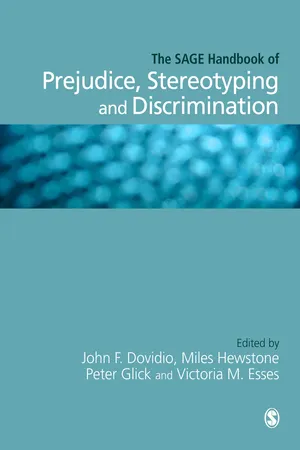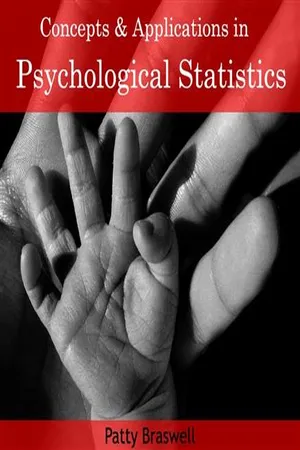Psychology
Developmental Psychology in Obedience/Prejudice
Developmental psychology in obedience/prejudice examines how individuals' attitudes and behaviors towards authority and social groups evolve over the course of their lives. It explores the factors that influence the development of obedience and prejudice, such as socialization, cognitive development, and moral reasoning. This field of study sheds light on how these psychological phenomena change as individuals grow and mature.
Written by Perlego with AI-assistance
Related key terms
1 of 5
3 Key excerpts on "Developmental Psychology in Obedience/Prejudice"
- John F Dovidio, Miles Hewstone, Peter Glick, Victoria M Esses, John F Dovidio, Miles Hewstone, Peter Glick, Victoria M Esses, SAGE Publications Ltd(Authors)
- 2010(Publication Date)
- SAGE Publications Ltd(Publisher)
The ability to reject stereotypes and prejudicial attitudes is a function, in part, of the nature of the issue, prior experience, social-cognitive evaluation, interpretation of competing considerations, and the source of influence (parental or peer) on the nature of the decision. CURRENT DEVELOPMENTAL INTERGROUP RESEARCH: AN OVERVIEW During the first decade of the twenty-first century, developmental intergroup research has expanded greatly to focus on a number of topics that reflect the same breadth of issues that have been investigated by social psychologists, including children’s prejudice, social identity, stereotypes and stereotype threat, discrimination, intergroup bias, ethnic identity intergroup contact, and exclusion, as reflected in recent volumes devoted to developmental intergroup attitude (Killen & McKown, 2005; Levy & Killen, 2008; Quintana & McKown, 2007). It is essential to note that developmental intergroup work greatly differs from most social devel-opmental research currently conducted in the area of developmental psychology. To date, most social developmental research, 102 BASIC PROCESSES AND CAUSES OF PREJUDICE, STEREOTYPING AND DISCRIMINATION particularly in the areas of children’s rejection and deviance has focused on individual differences. This research typically examines how psychological deviance stems from individual social deficits, such as a child’s temperament (wariness, fearfulness, behav-ioral withdrawal), lack of social skills, and aggressiveness, with an aim to understand and identify predictors of at-risk behaviors for unhealthy development or psychopathology (Rubin, Bukowski, & Parker, 2006). In contrast, developmental intergroup research shares the social psychological focus on the group (Asch, 1952), and on social attitudes (Dovidio & Gaertner, 2004).- No longer available |Learn more
- (Author)
- 2014(Publication Date)
- College Publishing House(Publisher)
______________________________ WORLD TECHNOLOGIES ______________________________ Chapter 7 Developmental Psychology Developmental psychology , also known as human development , is the scientific study of systematic psychological changes that occur in human beings over the course of their life span. Originally concerned with infants and children, the field has expanded to include adolescence, adult development, aging, and the entire life span. This field examines change across a broad range of topics including motor skills and other psycho-physiological processes; cognitive development involving areas such as problem solving, moral understanding, and conceptual understanding; language acquisition; social, personality, and emotional development; and self-concept and identity formation. Developmental psychology includes issues such as the extent to which development occurs through the gradual accumulation of knowledge versus stage-like development, or the extent to which children are born with innate mental structures versus learning through experience. Many researchers are interested in the interaction between personal characteristics, the individual's behavior, and environmental factors including social context, and their impact on development; others take a more narrowly focused approach. Developmental psychology informs several applied fields, including: educational psychology, child psychopathology, and forensic developmental psychology. Developmental psychology complements several other basic research fields in psychology including social psychology, cognitive psychology, ecological psychology, and comparative psychology. - No longer available |Learn more
- (Author)
- 2014(Publication Date)
- The English Press(Publisher)
________________________ WORLD TECHNOLOGIES ________________________ Chapter-1 Developmental Psychology Developmental psychology , also known as human development , is the scientific study of systematic psychological changes that occur in human beings over the course of their life span. Originally concerned with infants and children, the field has expanded to include adolescence, adult development, aging, and the entire life span. This field exa-mines change across a broad range of topics including motor skills and other psycho-physiological processes; cognitive development involving areas such as problem solving, moral understanding, and conceptual understanding; language acquisition; social, personality, and emotional development; and self-concept and identity formation. Developmental psychology includes issues such as the extent to which development occurs through the gradual accumulation of knowledge versus stage-like development, or the extent to which children are born with innate mental structures versus learning through experience. Many researchers are interested in the interaction between personal characteristics, the individual's behavior, and environmental factors including social context, and their impact on development; others take a more narrowly focused approach. Developmental psychology informs several applied fields, including: educational psychology, child psychopathology, and forensic developmental psychology. Develop-mental psychology complements several other basic research fields in psychology including social psychology, cognitive psychology, ecological psychology, and compara-tive psychology.
Index pages curate the most relevant extracts from our library of academic textbooks. They’ve been created using an in-house natural language model (NLM), each adding context and meaning to key research topics.


